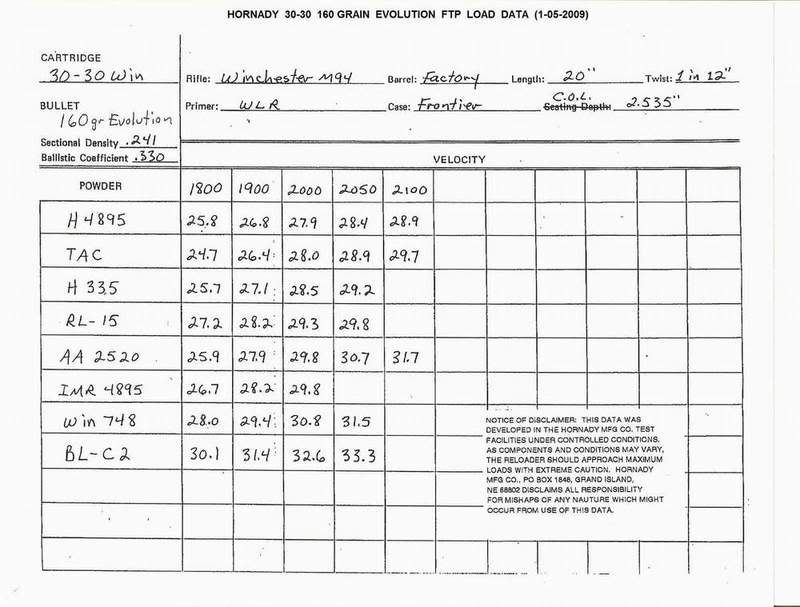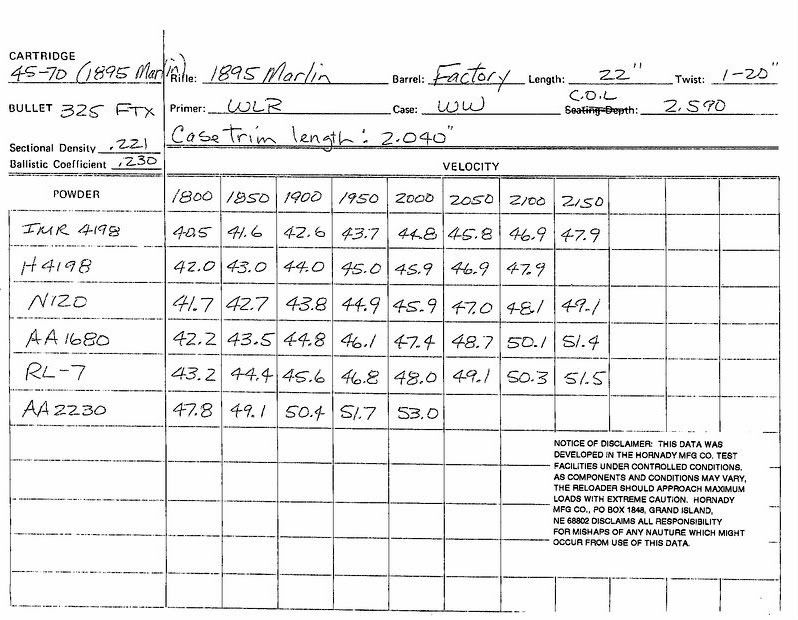|
|
Post by bigblue on Jan 15, 2009 15:46:08 GMT -6
I had requested some load data for Hornady's soon to be released FTX flex tip bullets and I thought I'd post it for those interested. I have data here for both the 30-30 and 45/70 loads. Don   |
|
|
|
Post by DocHolladay on Jan 15, 2009 18:36:22 GMT -6
I was looking at the new Hornady book I got a few weeks ago and they listed a 265gr ftx .44 bullet, but only sell the loaded ammo in 225gr. I get pretty good results with the .44 leverevolution ammo. I may try to load up some of the 265gr bullets once I get my supplies for that caliber. I was thinking of 290-300gr bullets though too.
|
|
|
|
Post by bigblue on Jan 15, 2009 19:06:53 GMT -6
I noticed they weren't offering the 225gr. FTX bullets. I thought that was kinda strange. I had tried the 325gr. factory loaded 45/70s and wasn't impressed with the accuracy and probably would never have bought any more. The ability to load it myself will help to tune it to the rifle, so I may give them a try.
I'll see what I can do on getting load data for the 265gr. in the .44 mag. I already sent in a request to Hornady for that data.
Don
|
|
|
|
Post by DocHolladay on Jan 15, 2009 20:01:06 GMT -6
Nice. I just need to get dies, powder and other supplies for it to start loading. Cant wait.
|
|
|
|
Post by juliang on Jan 16, 2009 4:18:41 GMT -6
I found it strange that the 45/70 had a higher maximum velocity than the 30/30. The max for 30/30 is only 2100, not as fast as standard 170gr which is 2200. Standard velocity in 45/70 300gr is normally about 1850. I realize that there all kinds of loads fr 45/70 depending on the strength of the action but those velocity figures quoted surprised me.
|
|
|
|
Post by bigblue on Jan 16, 2009 9:52:58 GMT -6
I guess a lot depends on what levels of pressure they feel comfortable with. Several bullet manufacturers give lower velocity data, Hornady and Speer are good examples of that. Hodgdon lists a max. charge of 36.0gr. of BL-C(2) as producing 2227FPS using a 170gr. Sierra FN bullet in the 30-30. Hodgdon also lists a max. charge of 60.0gr. of H4198 as giving a velocity of 2424FPS with Sierra's 300gr. HP bullets. So it's not uncommon to see the 45/70 using a 300gr. as outpacing the 170gr. from a 30-30.
Don
|
|
|
|
Post by bigblue on Jan 19, 2009 9:00:59 GMT -6
I received this Email today from Bob Palmer of Hornady's technical assistance:
"At this time we do not have the data for the 44 mag with the Flex Tipped
bullet. But you could use the 265 gr flat point load data from the 7th
addition book. "
So for now we can just use existing data to load their Flex tipped 265gr. .44 mag. bullets.
Hodgdon's H110 works very well in the .44 mag. and my suggestion would be to load the 265gr. FTX bullets with 16.6gr.-23.2gr. of H110 for a velocity ranging from 1200FPS-1700FPS. This data is from Hornady's 7th edition manual for use in a rifle. These figures are based on an 18" barreled Ruger carbine with a 1 in 38" rifling twist rate.
Don
|
|
|
|
Post by DocHolladay on Jan 19, 2009 12:18:22 GMT -6
Wow, isnt it a coincidence that I am shooting the same rifle that they tested the load in?
|
|
|
|
Post by bigblue on Jan 19, 2009 13:11:16 GMT -6
Sometimes things just work out right.
Don
|
|
|
|
Post by bubbawitha4570 on Jan 19, 2009 17:24:43 GMT -6
How will the OAL work out with the FTX bullets? I know the factory brass is shorter than standard, to make the OAL work, but with everything going into standard length cases won't there be a possiblity of higher pressures encountered? It shouldn't hurt much, as there is only appprox. .1" but.....
|
|
|
|
Post by bigblue on Jan 19, 2009 18:30:33 GMT -6
While I can't say that I've seen the .44 FTX bullets, I would think that they will have a crimp groove that will work with standard length cases. The fact that they are referring us to their 7th edition loading manual for data has me believing they have already worked it out and both their tech guys and lawyers are happy with the results. A quick look at their older manual shows me that they have lowered the recommended max. amount of powder in their newer manuals, which should give some wiggle room for pressure levels.
Don
|
|